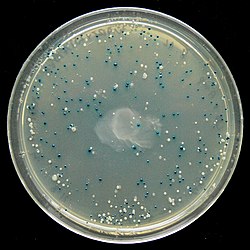Blåvit screening
| Den här artikeln behöver källhänvisningar för att kunna verifieras. (2019-12) Åtgärda genom att lägga till pålitliga källor (gärna som fotnoter). Uppgifter utan källhänvisning kan ifrågasättas och tas bort utan att det behöver diskuteras på diskussionssidan. |

Blåvit screening, blåvit selektion, är en molekylärbiologisk metod där man genom att studera E. coli-bakteriekoloniers färg kan avgöra om de har tagit upp en viss plasmid eller annan vektor med en önskvärd gen. Vektorn innehåller också en gen som ger resistens mot antibiotikumet ampicillin, så bakterier som inte har tagit upp någon vektor dör om de får växa på ampicillinplatta. Bakterier som har tagit upp rekombinanta vektorer (med den önskvärda genen) kan inte bryta ned ämnet X-gal till ett blått färgämne och blir vita, medan bakterier som har tagit upp vektorer utan den önskvärda genen kan bryta ned X-gal och blir blå.
För att användas i denna metod måste vektorn ha markörer för blåvit screening. Vektorn bär genen lacZ' som kodar för α-domänen av β-galaktosidas (intakt β-galaktosidas=lacZ-genen). Utan α-domänen är inte β-galaktosidas intakt och är därmed inte funktionellt. Uttrycket av lacZ' kontrolleras av sekvenser från lac-operonet som sitter uppströms i vektorn. Om laktos finns närvarande kan genen lacZ' uttryckas och α-delen av β-galaktosidas kan uttryckas. Då fås ett funktionellt β-galaktosidas som innehåller båda delarna. Detta kallas α-komplementering. β-galaktosidas är ett av enzymerna som bryter ner laktos till glukos och galaktos. I laboratoriemiljö används istället laktosanalogen IPTG som inte kan brytas ner av β-galaktosidas och som därför aktiverar lacZ'. Färgmarkören X-gal tillsätts för att ge selektionsmöjlighet. Då den hydrolyseras i närvaro av β-galaktosidas bildar den blå produkt. Vektorn som används har den egenskapen att polylinkern ligger i lacZ’-genen. Då ett DNA-fragment sätts in där kommer lacZ-genen att förstöras genom att den skiljs från sin promotor och transkription av genen kan inte starta. Ingen blå färg bildas, kolonierna blir vita. Blå kolonier är tomma, det vill säga att de innehåller vektorer som är återligerade (de har inte tagit upp DNA). Vita kolonier har tagit upp främmande DNA i polylinkern. De vita kolonierna är de önskvärda.
Insert inom lacZ ger vita kolonier.
Insert utanför lacZ eller inget insert ger blåa kolonier.
Media som används på denna webbplats
Författare/Upphovsman: Tkgd2007, Licens: CC BY-SA 3.0
A new incarnation of Image:Question_book-3.svg, which was uploaded by user AzaToth. This file is available on the English version of Wikipedia under the filename en:Image:Question book-new.svg
Författare/Upphovsman: Stefan Walkowski, Licens: CC BY-SA 4.0
Blue-white screening is a popular and efficient molecular biology technique for the identification of recombinant bacteria in cloning experiments.
It relies on the activity of the enzyme β-galactosidase (β-gal), naturally occurring enzyme in E. coli cells, which cleaves lactose molecules into glucose and galactose. β-gal is encoded by the lacZ gene in the bacterial chromosome. There is also the M15 strain of E. coli with a deletion mutation of a fragment of the Lac gene that produces an inactive β-gal (called ω-peptide).
Due to α-complementation process, E. coli strains with lacZΔM15 deletion mutation that carries the plasmid vector containing the lacZα sequence can produce the functional β-gal enzyme.
For screening the clones with recombinant DNA, X-gal, Isopropyl β-D-1-thiogalactopyranoside (IPTG) along with an antibiotic (such as ampicillin) is added to the medium. X-gal is a chromogenic substrate, and IPTG is a galactose analog that induces lacZ gene expression.
The plasmid vector is designed to contain multiple cloning site (MCS) is present within the lacZ sequence. Consequently, in the plasmid with an insert (foreign DNA), α-complementation does not occur, thus a functional β-galactosidase enzyme is not formed.
Blue colonies contain E. coli producing a functional enzyme that hydrolyzes X-gal, resulting in an insoluble blue pigment. In other words, these are bacteria without the insert that have a a functional LacZ gene.
White colonies are formed when a plasmid vector containing insert with foreign DNA (which disrupts the lacZ gene) is taken up by the E. coli, α-complementation does not occur, and therefore the functional enzyme β-gal is not produced. Next, the desired white recombinant colonies can be easily selected and cultured.
The presence of the antibiotic in the medium ensures that only E.coli containing a plasmid-borne antibiotic-resistance gene (eg. ampR selectable marker) can grow at all.
